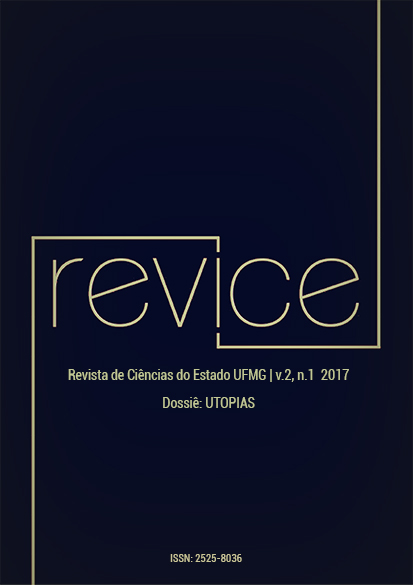Carnival land
The refined laughter of eutrapelia
DOI:
https://doi.org/10.35699/2525-8036.2017.5024Keywords:
Thirty-year's war, Utopia, Topsy-turvy world, Carnival, EutrapeliaAbstract
This article intends to understand the new meaning attributed to laughter and to Carnival by religious and civil authorities in the seventeenth century, with the object of research being Utopia, a Thomas Morus’s homonymous work, published in 1640 and written by Jakob Bidermann, German Jesuit, theater writer and future Inquisitor of the Catholic Church in Rome. The book recounts the journey of three friends to an imaginary country called Utopia, where the inhabitants celebrate an eternal Carnival, chaos is institutionalized, the rules of culture are suspended, citizens are masked, and drink and eat too much. The travelers experience the terrible consequences of this “topsy-turvy world” and the insecurities of a place that lives immersed in vice, vanity, violence and excesso. In the end, they discover that the real world, when based on Christian virtues and morality, and especially when guided by the Catholic Church, becomes a much more real, tranquil and beautiful place to live. This article also discusses the choice of title and the meaning of “utopia” conceived by the text.
Downloads
References
ARISTÓTELES. A Ética de Nicômaco. São Paulo: abril cultural, 1979.
AUERBACH, E. A novela no início do Renascimento. Itália e França. São Paulo: Cosac Naify, 2013.
BAKHTIN, M. Literatur und Karneval. Zur Romantheorie und Lachkultur. Munique: 1969.
__________. A cultura popular na Idade Média e no Renascimento: o contexto de François Rabelais. Edunb: São Paulo, 1996.
BENJAMIN, W. O drama barroco alemão. São Paulo:Editora Brasiliense, 1984.
BERNT, Günther. “Nachwort”. In. BRANDT-SCHWARZE, Ulrike; HACKEMANN, Matthias (orgs.). Carmina Burana. Munique: Deutscher Taschenbuch Verlag, 1979.
BERRIEL, Carlos Eduardo Ornelas. “Introdução”. In. BOCCACCIO, Giovanni. Decameron. Rio Grande do Sul: L&PM, 2013.
BOCCACCIO, G. Decameron. Rio Grande do Sul: L&PM, 2013.
BURKE, P. Cultura Popular na Idade Moderna. São Paulo: Companhia das Letras, 2010.
CARPEAUX, Otto Maria. Teatro e Estado do Barroco. Estudos Avançados, São Paulo, v. 4, 1990, s.p/.
___________. História concisa da literatura alemã. São Paulo: Faro Editorial, 2013
CORDIE, A. M. Raum und Zeit des Vaganten. Formen der Weltaneignung im deutschen Schelmenroman des 17. Jahrhunderts.Berlim: de Gruyter, 2001.
FIRPO, Luigi. Para uma definição da ‘”Utopia”. Morus – Utopia e Renascimento, São Paulo,v. 2, 2005, pp. 227-237
FORTUNATI, Vita. “Introduzione”. In. TROUSSON, Raymond. Viaggi in nessun luogo. Storia letteraria del pensiero utópico. Ravenna:Longo Editore Ravenna, 1992.
FRANCISCO DE SALES, Santo. Ouvres. Paris: Gallimard, 1969.
GAGNEBIN, J-M. Lembrar, escrever, esquecer. São Paulo: Editora 34, 2006.
GOUVERITSCH, Aaron. “Bakhtin and his theory of Carnival”. In. BREMMER, Jan; ROODENBURG, Hermann (orgs.). A cultural history of humour. Oxford: Polity Press, 1997, pp. 54-60.
GRIMMELSHAUSEN, H. J. C. O Aventuroso Simplicissimus. Curitiba: Ed. UFPR, 2008.
HUIZINGA, J. Outono da Idade Média.São Paulo: Cosac Naify, 2011.
KAYSER, W. O Grotesco. Configuração na pintura e na literatura. São Paulo: Editora Perspectiva, 1986.
KOCH, W. “A literatura barroca na Alemanha”. In. _____ Aspectos do Barroco II. Rio Grande do Sul: UFRS, 1967, pp. 73-93.
MARAVALL, J. A. A Cultura do Barroco. São Paulo: Edusp, 1997.
MINOIS, G. História do Riso e do Escárnio. São Paulo: Editora UNESP, 2003.
MOULIN, L. A vida dos estudantes na Idade Média.Lisboa: Edição Livros do Brasil, 1994.
MORUS, Thomas. Utopia. São Paulo: Editora Martins Fontes, 1999.
PRÉVOST, André. A Utopia: o gênero Literário. Morus – Utopia e Renascimento, São Paulo,v. 10, 2015, pp. 437-447.
ROSENFELD. A. Teatro Alemão. São Paulo: Editora brasiliense, 1968.
SCHUSTER, M. Jakob Bidermanns “Utopia”. Bern: Verlag Peter Lang AG, 1984.
THOMSEN, C. W. Das Groteske im Englischen Roman des 18. Jahrhunderts.Darmstadt: Büchner Verlag, 1974.
TOMÁS DE AQUINO, Santo. Suma de Teología. Madri: Biblioteca de Autores Cristianos, 1993.
___________________. “Tratado sobre o brincar”. In. Cultura e educação na Idade Média.São Paulo: Martins Fontes, 1998.
TROUSSON, R. Viaggi in nessun luogo. Storia letteraria del pensiero utópico.Ravenna:Longo Editore Ravenna, 1992.
WEDGEWOOD, C. V. Der Dreißigjährige Krieg. Munique: List, 1967. BRANDÃO, Júlia Ciasca. O país do carnaval: o refinado riso da eutrapelia. Data de Submissão: 14/01/2017 |
Downloads
Published
How to Cite
Issue
Section
License
Copyright (c) 2017 Júlia Ciasca Brandão

This work is licensed under a Creative Commons Attribution-NonCommercial-ShareAlike 4.0 International License.
1. Os conteúdos dos trabalhos são de exclusiva responsabilidade de seu autor.
2. É permitida a reprodução total ou parcial dos trabalhos publicados na Revista, desde que citada a fonte.
3. Ao submeterem seus trabalhos à Revista os autores certificam que os mesmos são de autoria própria e inéditos (não publicados em qualquer meio digital ou impresso).
4. Os direitos autorais dos artigos publicados na Revista são do autor, com direitos de primeira publicação reservados para este periódico.
5. Para fins de divulgação, a Revista poderá replicar os trabalhos publicados nesta revista em outros meios de comunicação como, por exemplo, redes sociais (Facebook, Academia.Edu, etc).
6. A Revista é de acesso público, portanto, os autores que submetem trabalhos concordam que os mesmos são de uso gratuito.
7. Constatando qualquer ilegalidade, fraude, ou outra atitude que coloque em dúvida a lisura da publicação, em especial a prática de plágio, o trabalho estará automaticamente rejeitado.
8. Caso o trabalho já tenha sido publicado, será imediatamente retirado da base da revista, sendo proibida sua posterior citação vinculada a ela e, no número seguinte em que ocorreu a publicação, será comunicado o cancelamento da referida publicação. Em caso de deflagração do procedimento para a retratação do trabalho, os autores serão previamente informados, sendo-lhe garantido o direito à ampla defesa.
9. Os dados pessoais fornecidos pelos autores serão utilizados exclusivamente para os serviços prestados por essa publicação, não sendo disponibilizados para outras finalidades ou a terceiros.



